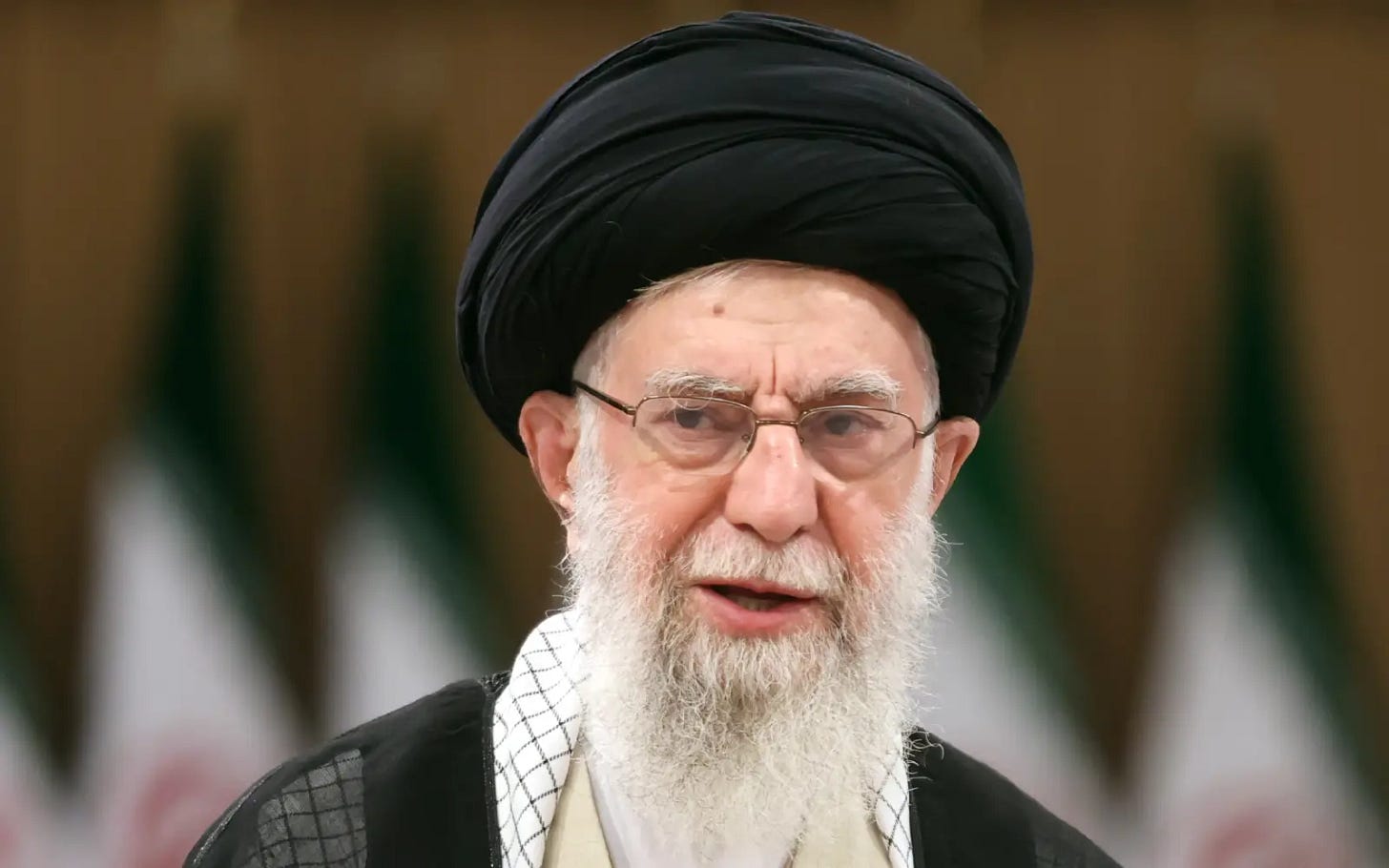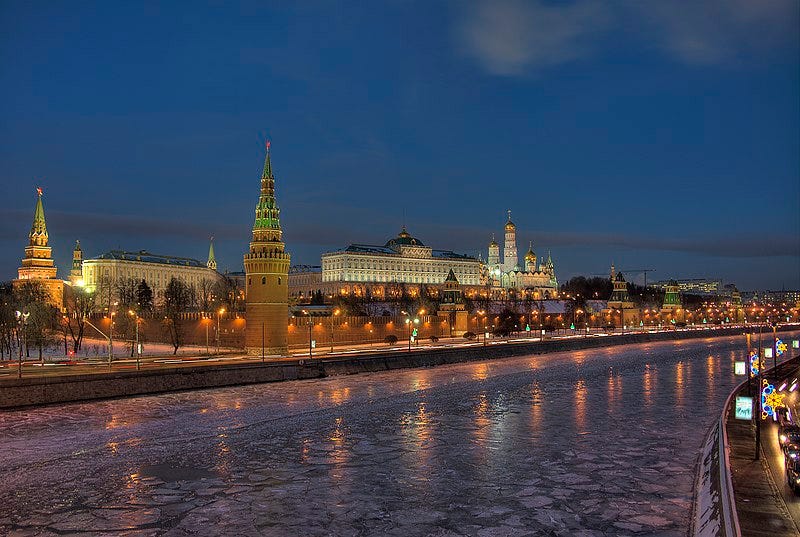Reports that Iran is withdrawing from Iraq and Yemen have raised speculation that the country is undergoing some kind of transformation in its relations with Donald Trump, or alternately, that the regime is planning some sort of trick, perhaps even a nuclear breakthrough.
Without discounting either explanation, another, more likely immediate explanation presents itself: the regime is contracting its strategic presence out of short-term security concerns, and not out of courtesy to President Trump. A handover of power is looming and they want to have every Iranian who is important sitting somewhere that they can be seen at all times.
Seen above, Ayatollah Ali Hosseini Khamenei, the second “supreme jurist” (velayat-i-faqih) in the history of the Islamic Republic of Iran, turns 86 this month. He has been in power since 1989.
His second son, Sayyed Mojtaba Hosseini Khamenei, was elevated to the clerical rank of ayatollah in 2022 amid rumors of his father’s ill health. Those rumors have only grown louder over time as the father has gone long periods without speaking or appearing in public.
By happy coincidence(?), Mojtaba’s greatest political adversary, President Ebrahim Raisi, was killed in a helicopter accident(?) in May of last year.
Then in September, Mojtaba suddenly suspended his classes after fifteen years as a religious instructor, making the announcement on social media without any clear explanation.
All the pieces have been put in place for the peaceful handover of Iran’s supreme authority to an heir — except for the “peace” part. Because Iran, we now know, funded and inspired the 7 October 2023 pogroms in southern Israel, a colossal strategic error.
First the IDF neutered HAMAS, systematically destroying the organization and its infrastructure in stages. Then Mossad undertook a massive pager-bomb attack that neutralized the middle management of Hezbollah while the IDF busted every leadership bunker.
That was bad enough. But then Turkey’s proxy in Idlib drove Iran’s Syrian ally, Bashar al-Assad, into exile, forcing Iran to withdraw what was left of its shattered expeditionary force from that country in humiliation.
Even the Red Sea, where the Houthis have arguably cost the West billions and shot down some expensive drones, has been a strategic failure. Shipping traffic still goes through the Bab al-Mandab and the Red Sea; the companies simply pay higher insurance premiums.
It was however still a surprise last week when Tehran reportedly told their military advisors in Yemen to come home. A senior Iranian official indicated that support for regional proxies was being reduced in the face of threats from the new Donald Trump administration.
Proxy groups in Iraq have also reportedly lost their support and advisors. Six militia commanders in Baghdad told Reuters that the Trump government has been warning the Iraqi government about airstrikes for some time, and that their Iranian backers have backed down.
The commanders said their main ally and patron, Iran's elite Revolutionary Guards (IRGC) military force, had given them its blessing to take whatever decisions they deemed necessary to avoid being drawn into a potentially ruinous conflict with the United States and Israel.
The militias are part of the Islamic Resistance in Iraq, an umbrella group of about 10 hardline Shi'ite armed factions that collectively command about 50,000 fighters and arsenals that include long-range missiles and anti-aircraft weapons, according to two security officials who monitor militias' activities.
It would be too easy to take all this at face value, judge that the IRGC has accepted defeat, and credit the Trump administration for using threats of force to force strategic change on the regime. Regular readers know that I certainly don’t object to this approach.
These are outside pressures, however. If Ali Khamenei really is at death’s door, on the other hand, then the imminent vacuum of power at the center would better explain the withdrawal response in the face of those threats.
Mojtaba is 55. He will need the support of the IRGC to become the new supreme jurist. In turn, the IRGC will want to crack down on anything that even looks like a protest. Maintaining the appearance of domestic tranquility will be key to a successful transition of power.
They will also want to prepare for the transition internally, for example by shaking up commands and redistributing offices, and also externally, for example by preparing to, say, take over a state asset, or round up internal political opponents, during the power shuffle that accompanies Mojtaba’s installation. Expect shenanigans, in other words, but expect them to take place inside Iran.
Do not expect happy changes, however. Mojtaba will need to be confirmed by the Assembly of Experts, one of the unique organs of Iran’s complex constitution. Khomeini designed this feature of his system specifically to prevent any great, sweeping changes in Iran. To call its current director, ninety-three-year-old Movahedi Kermani, ‘conservative’ would be an understatement.
Mojtaba was widely seen as the hidden hand behind the election of Mahmoud Ahmadinejad, a fellow hardliner, in 2005. Then in 2009, Mojtaba took personal charge of putting down the street protests after he arranged the reelection of Ahmadinejad. With that political resumé, the ultraconservative Mojtaba is likely quite acceptable to the IRGC and Assembly of Experts.
Asuming that the hand-off of power from father to son is imminent, we should not expect the new regime to be any friendlier to Trump or America than the old one, either. Mojtaba will continue opposing the Great Satan. Indeed, the one change he might make in his first year in charge is a jurisprudential case for nuclear breakout. His father has so far maintained a public opposition to nuclear weapon development.
Here is where the interpretation of Iran’s reported regional withdrawal as a general retreat from Trump’s threats meets its rational limitation. In other words, fear has only pushed them so far. They have other motivations, too. Some things are still sacred to the regime and will not be surrendered, most of all the nuclear program.
In the fact sheet with his 4 February executive order, Trump announced a “National Security Presidential Memorandum (NSPM) restoring maximum pressure on the government of the Islamic Republic of Iran, denying Iran all paths to a nuclear weapon, and countering Iran’s malign influence abroad.”
“President Trump will not tolerate Iran possessing a nuclear weapons capability,” the fact sheet emphasized. But he may very well have to tolerate it.
Ali Akbar Salehi, former chief of the Atomic Energy Organization of Iran, told an Iranian state TV program in February 2024 that "we have all the [pieces] of nuclear science and technology” to build a nuclear bomb.
Salehi compared a nuclear weapon to a car, which consists of “a chassis, it needs an engine, it needs a steering wheel, it needs a gearbox. Have you made a gearbox? I say yes. An engine? But each one is for its own purpose.”
Iran has not built a nuclear weapon, exactly. Rather, Iran has spun up uranium enrichment centrifuges while they work on the other various parts of a nuclear weapon.
“New intelligence about Iran’s nuclear program has convinced American officials that a secret team of the country’s scientists is exploring a faster, if cruder, approach to developing an atomic weapon if Tehran’s leadership decides to race for a bomb,” the New York Times reported in February.
At some point, whenever the regime desires, they can put all the parts of a nuclear bomb together and see if it works. Better yet, from Tehran’s perspective, they can have lots of these nuclear weapons ready put together to deter any attacks on Iranian territory.
Threatening nuclear use in response to threats against their foreign proxies, on the other hand, would be much harder to justify than nuclearization in defense of Iran itself. The flip side of regional withdrawal may be plans for nuclear breakout in the near future.
There are two reasons why Mojtaba Khamenei might do this. The first is that Iran is sorely lacking a strategic deterrent right now. The conventional deterrent they built against Israel proved woefully inadequate one year ago, when Tehran struck directly at Israel with a reported 170 drones, more than 30 cruise missiles, and 120 ballistic missiles.
A multinational intervention and Israeli air defenses combined to intercept and nullify the bombardment. Iran scored only a handful of hits, none of them doing any real damage or inflicting major casualties. Start putting nuclear warheads on the missiles and drones, however, and that same high interception rate will not be enough to prevent mass destruction or mass casualties.
The second reason why Mojtaba might choose nuclear proliferation is Donald Trump. During the Obama administration, Iran’s uranium enrichment program was a powerful bargaining tool for the regime. The JCPOA (Joint Comprehensive Plan of Action) had critics within the regime who denounced it as “capitulation” to the west.
But then Donald Trump abrogated the agreement, inspiring “a perpetual sense of victimization and outrage” in Iran, according to Ali Parchami. As a result, the enrichment program has become a sacred project instead of a bargaining chip.
Now Trump is trying to replace the treaty he tore up. Iran had formally rejected direct negotiations, citing “breach of promises,” but then the minister of foreign affairs, Seyed Abbas Araghchi, announced a willingness to have indirect talks Tuesday in the Washington Post.
Aragchi’s first order of business is to get Trump to back down from his military threats. “To move forward today, we first need to agree that there can be no ‘military option,’ let alone a ‘military solution,’” Araghci wrote. But what are the chances?
Trump says there will be a “direct” meeting on Saturday, and “a very big meeting.” His team is talking about a “tougher” deal than the JCPOA, while on the Iranian side, there is internal pressure to demand greater promises this time. It is highly likely these two sides will talk right past each other.
Businessman Steve Witkoff will lead the American side. On the Iranian side, technocrats and competent diplomats have also been sidelined for regime loyalists in recent years. The two sides are unlikely to hold a constructive dialogue about, say, uranium enrichment levels, inspection regimes, or centrifuges.
Perhaps Ali Khamenei is serious. Maybe he really hopes that these “indirect” talks will lead somewhere. The chances are slim, however, because right now he has regime survival foremost on his mind, and Trump seems eager to push Iran over the brink. Military defeat has altered the strategic calculus in Iran, but that does not mean peace is breaking out.
Why The Russian World Is Borderless
The Russian Orthodox Church (ROC) has led the militarization of Russian society at every level. The priesthood trains children in fieldcraft, convinces balky conscripts to fight, and “takes the ideas generated by state ideology and imbues them with sacred meaning,” according to Archpriest Andrei Kordochkin.





